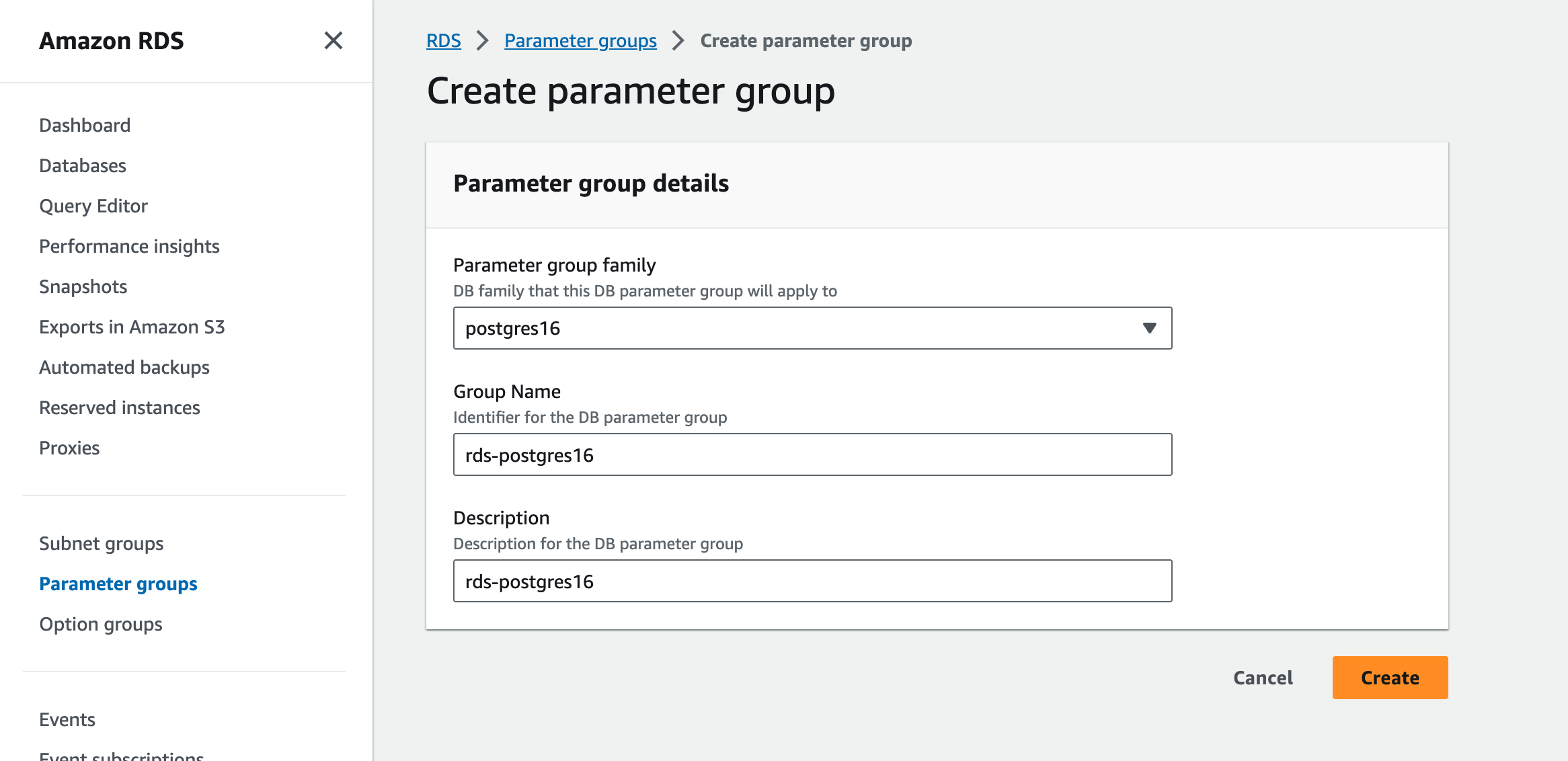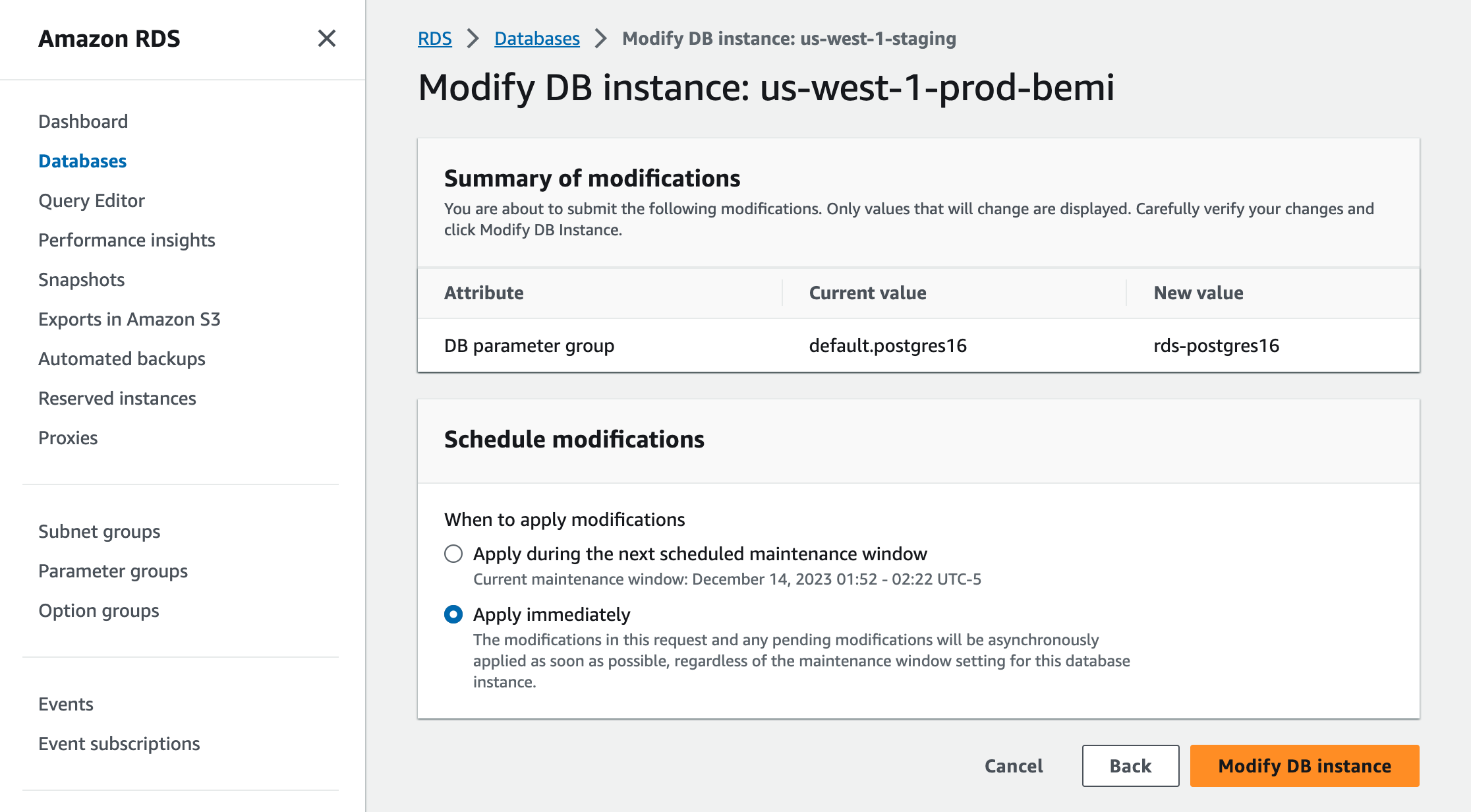Amazon Web Services RDS
WAL level
At a high level, these are the steps necessary to update the WAL level from replica to logical
- Create an RDS parameter group if it doesn’t exist
- Update
rds.logical_replicationparameter from 0 to 1 - Apply the parameter group to your RDS instance and restart it
Now let's break down these steps.
Create an RDS parameter group if it doesn’t exist by choose the group family depending on your PostgreSQL version and specifying any name and description:

Edit the created parameter group:

Find and change the rds.logical_replication parameter from 0 to 1:

Find and modify your RDS instance by using the parameter group:

Apply the modification by restarting your RDS instance:

If you have a Multi-AZ database cluster and you used a cluster parameter group, you will need to explicitly Reboot the Writer instance (it may take ~ 2 seconds if there is not a lot of activity). The Reader endpoint will continue to be available without downtime.

See the AWS RDS user guides to learn more about parameter groups.
Connection
You can specify the same regular database credentials you use to connect to PostgreSQL from your code. And that's it, everything should just work!
Read-only credentials
Alternatively, you can manually create read-only PostgreSQL database credentials to connect to the primary instance's WAL. At a high level, you need to run these commands that are safe to execute without any downtime or performance issues:
CREATE ROLEcreates a new read-only user for Bemi to read database changes.CREATE PUBLICATIONcreates a "channel" that we'll subscribe to and track changes in real-time.REPLICA IDENTITY FULLenhances records stored in WAL to record the previous state (“before”) in addition to the tracked by default new state (“after”).
-- Create read-only user
CREATE ROLE [username] WITH LOGIN NOSUPERUSER NOCREATEDB NOCREATEROLE NOREPLICATION PASSWORD '[password]';
-- Grant RDS replication permission
GRANT rds_replication TO [username];
-- Grant SELECT access to existing tables for selective tracking
GRANT SELECT ON ALL TABLES IN SCHEMA public TO [username];
-- Grant SELECT access to new tables created in the future for selective tracking
ALTER DEFAULT PRIVILEGES IN SCHEMA public GRANT SELECT ON TABLES TO [username];
-- Create "bemi" PUBLICATION to enable logical replication
CREATE PUBLICATION bemi FOR ALL TABLES;
-- Create a procedure to set REPLICA IDENTITY FULL for tables to track the "before" state on DB row changes
CREATE OR REPLACE PROCEDURE _bemi_set_replica_identity() AS $$ DECLARE current_tablename TEXT;
BEGIN
FOR current_tablename IN SELECT tablename FROM pg_tables LEFT JOIN pg_class ON relname = tablename WHERE schemaname = 'public' AND relkind != 'f' AND relreplident != 'f' LOOP
EXECUTE format('ALTER TABLE %I REPLICA IDENTITY FULL', current_tablename);
END LOOP;
END $$ LANGUAGE plpgsql;
-- Call the created procedure
CALL _bemi_set_replica_identity();
-- Create a trigger function that calls the created procedure
CREATE OR REPLACE FUNCTION _bemi_set_replica_identity_func() RETURNS event_trigger AS $$
BEGIN CALL _bemi_set_replica_identity(); END $$ LANGUAGE plpgsql;
-- Create a trigger to set REPLICA IDENTITY FULL for all new created tables
CREATE EVENT TRIGGER _bemi_set_replica_identity_trigger ON ddl_command_end WHEN TAG IN ('CREATE TABLE')
EXECUTE FUNCTION _bemi_set_replica_identity_func();
Read-only credentials with manually managed permissions for each table
Run the following queries if you want to isolate read access only to logical replication for certain tables and manage permissions manually instead of relying on our robust built-in selective tracking manageable through our UI.
-- Create read-only user
CREATE ROLE [username] WITH LOGIN NOSUPERUSER NOCREATEDB NOCREATEROLE NOREPLICATION PASSWORD '[password]';
-- Grant replication permission to allow using replication slots
GRANT rds_replication TO [username];
-- Create "bemi" PUBLICATION to enable logical replication for selected tables
CREATE PUBLICATION bemi FOR TABLE [table1], [table2];
-- Set REPLICA IDENTITY FULL for tables to track the "before" state on DB row changes
ALTER TABLE [table1] REPLICA IDENTITY FULL;
ALTER TABLE [table2] REPLICA IDENTITY FULL;
To enable data change tracking for a new table:
ALTER PUBLICATION bemi ADD TABLE [table3];
ALTER TABLE [table3] REPLICA IDENTITY FULL;
To stop data change tracking for a table:
ALTER PUBLICATION bemi DROP TABLE [table3];
ALTER TABLE [table3] REPLICA IDENTITY DEFAULT;